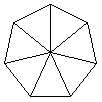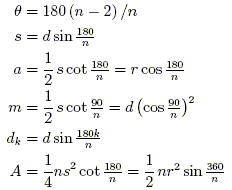Below is a table and diagram summarizing the variables used in the explanation. Angles are measured in degrees throughout so that this information will be accessible to students who have not worked in radians. The results can be converted to radians using the conversion 180° = π radians.
 A | area enclosed by polygon
| a | apothem (radius of inscribed circle)
| dk | length of kth diagonal
| d | diameter of circumscribed circle
| m | length of median
| n | number of sides
| p | perimeter
| r | radius of circumscribed circle
| s | length of side
| α | smallest angle formed by a diagonal and a side
| θ | angle formed by consecutive sides
| φ | angle formed by consecutive radii (the central angle)
| |

The perimeter of a regular n-gon with side length s is p = ns. To find the area, we divide the polygon into n congruent triangles by drawing segments from the center to each vertex, as illustrated for the septagon to the right.
The sum of the central angles is 360° since it represents the interior angle of a circle, so φ = 360/n. The area of each triangle is as/2 and there are n triangles, so A = nas/2 is the area of a regular n-gon with side length s and apothem a. This can be simplified to A = ap/2; this formulation provides a basis for generalization to higher dimensions.
The sum of the interior angles of a triangle equals 180°, so 180 = φ + θ; this gives

after substition for φ. Then the sum of the angles of a (regular) polygon is nθ = 180(n – 2).
In the same triangles used above, the law of sines gives
which we can use to find s in terms of the radius r:
 | (1) |
where d = 2r is the diameter of the circumscribed circle.
By the Pythagorean theorem,
Substituting from equation (1) gives

which we solve for a to obtain
 | (2) |
| (3) |
When n is odd, m = r + a. Substituting for a and r yields
 | (4) |
Finally we will find the lengths of diagonals in a regular polygon. From a given vertex, draw a segment to each of the n – 1 other vertices, and call the lengths of these segments (in order) d1, d2, ..., dn – 1, as illustrated below.

d1 = dn – 1 = s because these lengths correspond to sides of the polygon. Define α as the angle between any two consecutive segments di and di + 1. All these angles are the same because they subtend the same arc length of the circle. Specifically, by the angle in circle theorems, α = φ/2 = 180/n. (This can also be obtained from the equation 180 = θ + 2α, which is the sum of the angles in the triangle formed by two consecutive sides and a d2 diagonal.)
For k = 2, 3, ..., n – 2, let θk be the angle opposite of diagonal k in the triangle formed a side, diagonal k, and diagonal k – 1. Then θ2 = θ and θn – 1 = α, and in general
By the law of sines in the kth triangle,
 | (5) |
To summarize, the following equations hold for regular polygons (n ≥ 3).
 |  |


